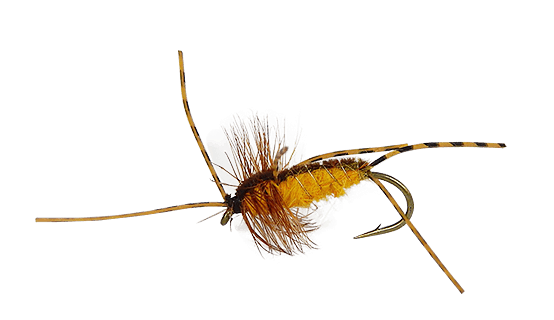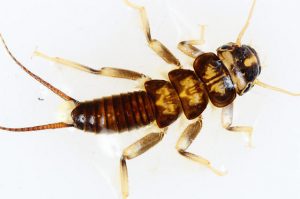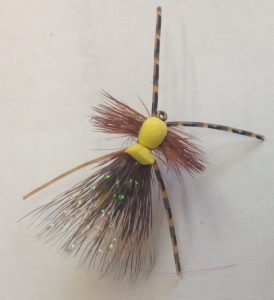 Since we’re talking about big browns this month, I thought it only fitting to feature one of my favorite flies for big brown trout. While I have caught a number of big browns on small flies over the years, most of the big guys in the mountains have come on larger stonefly nymphs. This is a little bit misleading as most of the large browns I’ve caught in the Smokies I spotted before I fished for them. And when I spot a big brown trout, I almost always tie some sort of stonefly nymph imitation to my line. Who is to say I wouldn’t have caught those same fish on a #20 Zebra Midge had I chosen that fly?
Since we’re talking about big browns this month, I thought it only fitting to feature one of my favorite flies for big brown trout. While I have caught a number of big browns on small flies over the years, most of the big guys in the mountains have come on larger stonefly nymphs. This is a little bit misleading as most of the large browns I’ve caught in the Smokies I spotted before I fished for them. And when I spot a big brown trout, I almost always tie some sort of stonefly nymph imitation to my line. Who is to say I wouldn’t have caught those same fish on a #20 Zebra Midge had I chosen that fly?
I’ve always said that fly selection is 45% scientific, 45% experience, and 10% dumb luck. The scientific aspect comes in when you choose a fly to specifically imitate something that the fish are known to be feeding on. For example, if you see sulfur mayflies hatching, you see fish feeding on them, and you choose a sulfur mayfly imitation, you’ve more or less made a scientific decision. If you go to the stream and tie on a Royal Wulff for no other reason than you’ve always done pretty well on a Royal Wulff, you’ve made your decision based on experience. And of course, if you choose to fish the purple and green fly for no other reason than it looks neat, you’re pretty much depending on dumb luck!
All three methods have been successful over the years but the first two are usually more reliable because you have something at least somewhat logical and reliable to base the decision on. Even when your logic may be incorrect, such as choosing a sulfur to imitate a perceived sulfur hatch when the fish are actually eating caddis, you tend to have more success because you have confidence in your fly. When you have confidence in your fly pattern, you tend to fish it longer and better.
My tendency to select a stonefly nymph when I fish to a big brown trout comes from scientific reasoning and experience. I’ve studied the aquatic entomology of the Smokies and know that there are a lot of stonefly nymphs in the streams. I also reason that a larger morsel of food, like a stonefly nymph, would be more enticing to a larger fish. And I’m also relying on experience – I’ve caught a lot of big brown trout on stonefly nymphs over the years.

Some of my favorite “go-to” stonefly patterns over the years have been old standards like a Tellico Nymph, a Bitch Creek Nymph, and a Girdle Bug. I always liked the coloring of the Tellico because I thought it best represented a golden stone, which seems to be the most prolific big stonefly in most Smoky Mountain streams. I liked the flat, two-tone profile of the Bitch Creek Nymph. It seems to produce a nice rocking motion on the drift. And while the Bitch Creek Nymph does incorporate rubber legs in the design, the additional rubber legs on a Girdle Bug always seemed to give it a much more lifelike appearance.
So what did I do? I took what I thought were the best features from each of my favorite stonefly nymph patterns and blended them into one fly. The result is Rob’s Hellbender Nymph. It has the flat, elongated, two-tone profile of a Bitch Creek, the multiple rubber legs of a Girdle Bug, and a color similar to the Tellico.
I weight these flies with lead wire that is flattened to provide that rocking motion in the water. I not only tie them in different sizes, usually #10 – #4, but I tie them in different weights. To get down fast in deep, fast runs, I like a lot of weight, but I prefer a lightly weighted one when casting to a brown trout in the shallows.
For whatever reason, offering flies in different weights tends to be too confusing to customers at a fly shop so commercially tied patterns like this one are typically made available in one uniform weight. So the ones you find in a shop like Little River Outfitters are going to be lightly weighted so the fly can be fished in slower, shallower water. To get them down quickly in deeper, faster runs, just add the appropriate amount of split shot.
While I may choose something like a large streamer when searching for big browns, this fly has become my “go-to” for a large brown that I have spotted first. Of course, every situation is different and there will be countless circumstances that suggest otherwise. But next time you’re in the Smokies with a big brown in your sights, see what he thinks about this bug!
Learn more about Smoky Mountain hatches and flies in my hatch guide.

 As about anyone who knows me can tell you, I’m terrible at self-promotion. The worst. So it should come as no surprise that I’ve never featured one of my own patterns in the newsletter. Usually I opt for more standard or classic patterns. But this is a good fly and it’s good this time of the year, so here you go!
As about anyone who knows me can tell you, I’m terrible at self-promotion. The worst. So it should come as no surprise that I’ve never featured one of my own patterns in the newsletter. Usually I opt for more standard or classic patterns. But this is a good fly and it’s good this time of the year, so here you go!